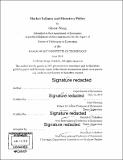Market failures and monetary policy
Author(s)
Wang, Olivier.
Download1119389390-MIT.pdf (14.00Mb)
Other Contributors
Massachusetts Institute of Technology. Department of Economics.
Advisor
Iván Werning and Ricardo J. Caballero.
Terms of use
Metadata
Show full item recordAbstract
Each chapter of this thesis focuses on the interactions between a particular market failure, such as financial frictions or imperfect competition, and the real effects of monetary policy. The first chapter studies the effect of low interest rates on financial intermediation and the transmission of monetary policy. Using U.S. bank- and branch-level data, I document two new facts: first, the long-run decline in bond rates has not been fully passed through to loan rates; second, the short-run pass-through of policy rates to loan rates is lower at lower rates. To explain these facts, I build a model in which banks provide both credit and liquidity, and the nominal interest rate affects the composition of bank interest income between loan and deposit spreads. In the long run, a decline in the equilibrium real rate r* compresses deposit spreads but increases loan spreads. In the short run, the sensitivity of output to monetary shocks is dampened relative to a benchmark with perfect pass-through, and even more so the lower r* is: I find a dampening that grows from 20% to 32% as r* falls from 3% to -1%. A higher inflation target can redistribute from depositors to borrowers and enhance monetary policy transmission. In the second chapter, I propose incomplete exchange rate pass-through as a new channel through which balance sheet effects can constrain monetary policy. I consider a New Keynesian open economy with external debt in foreign currency. I first show that absent heterogeneity within the country, outstanding external debt imposes no constraint on monetary policy under complete pass-through. If, however, pass-through is incomplete, then the expenditure switching benefits of a depreciation are weakened, while the strength of debt deflation is unchanged. As a result, sudden stops are contractionary, and prior current account deficits are inefficiently high due to aggregate demand externalities. Optimal macroprudential policy makes the private sector internalize the social value of future exchange rate flexibility. Absent perfect macroprudential tools, monetary policy would like to deter borrowing by promising a large, but time-inconsistent, depreciation during crises. I extend the model to capital flows within currency unions to show how the interaction of goods pricing and debt denomination slowly destroys the option value of exiting the union upon a crisis. The third chapter is joint with Iván Werning. We study oligopolistic competition and its effect on monetary policy. In our model, within each sector, any finite number of firms compete a la Bertrand. Firms can change their posted nominal prices at random intervals a la Calvo. Following an extensive IO literature, we focus on Markov equilibria of the resulting game in each sector. We aggregate up to the macroeconomic level and study unexpected monetary shocks. Our main result provides a closed-form formula for the response of aggregate output, highlighting three measurable sufficient statistics: demand elasticities, market concentration, and markups. We also separate the strategic effects of market concentration from its effects on the residual demand system. Higher concentration may significantly amplify or dampen the real effects of monetary policy, but the response approximates a recalibrated monopolistic competition model with Kimball demand, if one matches the local demand elasticities of the oligopolistic model.
Description
Thesis: Ph. D., Massachusetts Institute of Technology, Department of Economics, 2019 Cataloged from PDF version of thesis. Includes bibliographical references.
Date issued
2019Department
Massachusetts Institute of Technology. Department of EconomicsPublisher
Massachusetts Institute of Technology
Keywords
Economics.